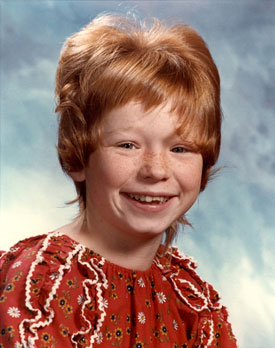Churchville, Webster, and Macedon—became forever linked to the tragedy
By: Johanna Elattar, pictured is 11 year old victim Wanda Walkowicz
Western New York has seen its share of crime over the decades, but few cases have left such a lasting mark on the region as the Alphabet Murders. In the early 1970s, Rochester was rocked by the brutal murders of three young girls—Carmen Colón, Wanda Walkowicz, and Michelle Maenza. The eerie pattern of their names and the horrifying similarities in their deaths gripped the community with fear and launched one of the most notorious unsolved crime investigations in the state’s history.
More than 50 years later, the case remains open, with law enforcement still searching for answers and families still hoping for justice. While Rochester has changed in many ways since the 1970s, the scars of these crimes remain, a dark chapter in Western New York’s history that refuses to close.

The Victims: Lives Cut Short
The three young victims all lived in Rochester and were described as kind, caring, and full of life before their tragic ends. Their deaths left an impact not just on their families, but on the entire Western New York community.
Carmen Colón (1961 – 1971)
Carmen Colón was a 10-year-old girl known for her bright personality and infectious laugh. She lived in a Spanish-speaking neighborhood in Rochester with her family, who had emigrated from Puerto Rico in search of a better life. Despite her young age, Carmen had a feisty spirit and was loved by many in her community.
On November 16, 1971, she was sent to a pharmacy on West Main Street to pick up a prescription for her grandmother. She never made it home. Witnesses later reported seeing a terrified young girl, partially undressed, running along Interstate 490, desperately waving for help. No one stopped.13 pt
Two days later, her body was found in Churchville, a rural town in Monroe County, about 12 miles outside of Rochester. She had been sexually assaulted and strangled. Her death sent shockwaves through Western New York, but at the time, it was thought to be an isolated tragedy.
Wanda Walkowicz (1961 – 1973)
Wanda Walkowicz was 11 years old, a quiet and responsible child who took on a lot of responsibilities at home. She lived in a working-class neighborhood in Rochester and often helped take care of her younger siblings.
On April 2, 1973, Wanda was sent to a local grocery store on Avenue D to pick up food for the family. She was last seen carrying a bag of groceries as she walked home. She never arrived.
Her body was found the next day in Webster, a suburb of Rochester, along Route 104—about seven miles from where she was last seen. The circumstances of her murder mirrored Carmen’s: she had been sexually assaulted and strangled. By this point, authorities began to suspect that a serial predator was targeting young girls in the area.
Michelle Maenza (1961 – 1973)
Michelle Maenza was another 11-year-old from Rochester, described as a sweet, soft-spoken child who loved playing with her friends. She had just finished school for the day on November 26, 1973, when she began walking home—a walk she had done many times before.
Eyewitnesses saw Michelle speaking to a man in a car before she disappeared. Two days later, her body was found in Macedon, about 15 miles southeast of Rochester in Wayne County. The similarities to the previous murders were undeniable: Michelle had also been sexually assaulted and strangled.
The terrifying pattern was now clear: all three victims had the same first and last initials, all were abducted from Rochester, and all were found in rural areas outside the city.

Fear Grips Rochester and Western New York
By the time Michelle’s body was found, fear had consumed Rochester and its surrounding communities. Parents were afraid to let their children walk alone, and students were escorted to and from school in large groups. The city, once seen as a relatively safe place to raise a family, now had a dark cloud hanging over it.
The rural towns where the girls’ bodies were found—Churchville, Webster, and Macedon—became forever linked to the tragedy. Many Western New Yorkers who lived in those areas during the 1970s still recall the terror and suspicion that followed the murders. People became wary of strangers, and communities grew increasingly protective of their children.
The case also put law enforcement in Monroe and Wayne counties under immense pressure to catch the killer. Despite countless interviews and investigations, no arrests were made.
Theories and Suspects
Over the years, multiple suspects have emerged, but none have been definitively linked to the murders.
Miguel Colón
One of the earliest suspects was Miguel Colón, Carmen’s uncle. He had a criminal past and reportedly left Rochester for Puerto Rico shortly after her murder. Though he was questioned multiple times, there was never enough evidence to charge him.
Kenneth Bianchi
Another name that surfaced was Kenneth Bianchi, later infamous as one of the “Hillside Stranglers,” responsible for multiple murders in California. Bianchi had lived in Rochester at the time of the Alphabet Murders and worked as an ice cream vendor, giving him access to children. However, no concrete evidence ever linked him to the crimes.
A Possible Serial Killer
Some investigators have theorized that the murderer may have been a transient serial killer who moved through Western New York and beyond. Given the rural locations of the bodies and the ability to travel between counties undetected, it’s possible that the perpetrator was someone with knowledge of the area, such as a truck driver or delivery worker.
The Case Today: Could DNA Provide Answers?
With advances in forensic technology, investigators have revisited the case in hopes that DNA evidence could finally lead to the killer. In recent years, other long-unsolved murders have been cracked using genetic genealogy, a technique that traces DNA to distant relatives of a suspect.
In 2022, Monroe County investigators confirmed they were still working on the case, testing evidence with the latest forensic tools. However, as of now, no major breakthroughs have been publicly announced.
For the families of Carmen, Wanda, and Michelle, the pain has never faded. Their stories remain a haunting reminder of the dangers that once lurked in Rochester, and the case still serves as a warning that evil can exist even in the safest-seeming places.
A Lasting Impact on Western New York
The Alphabet Murders left an indelible mark on Rochester and Western New York. Parents became more protective, children were taught to be wary of strangers, and the case forever changed how missing child investigations were handled in the region.
While Rochester has evolved since the 1970s, the memory of Carmen, Wanda, and Michelle lingers. The streets they once walked are still there, the neighborhoods they called home still standing, but their absence is felt by those who remember.
Until their killer is found, their case remains a painful open wound in the history of Western New York. Perhaps one day, through new technology or an unexpected confession, justice will finally be served. Until then, the people of Rochester—and beyond—continue to wait.










